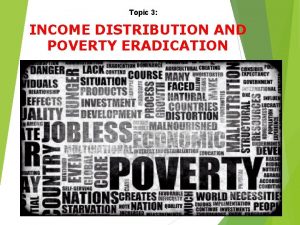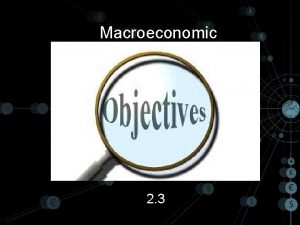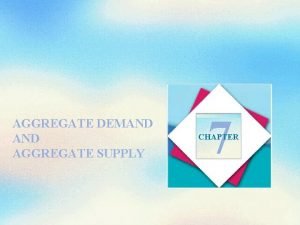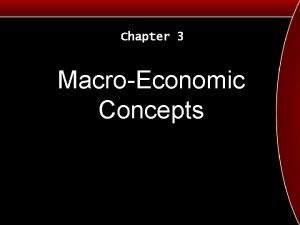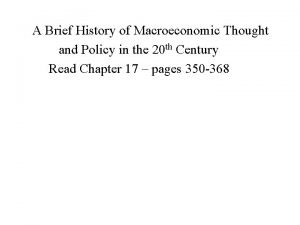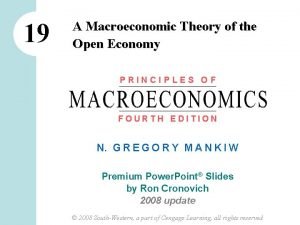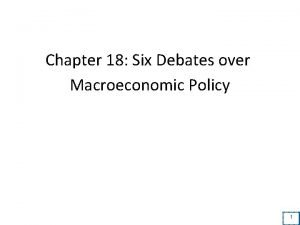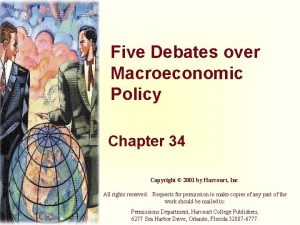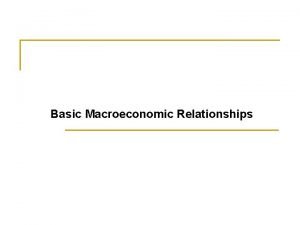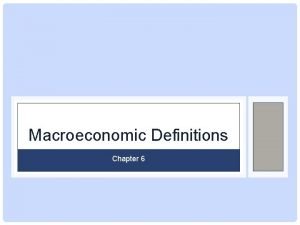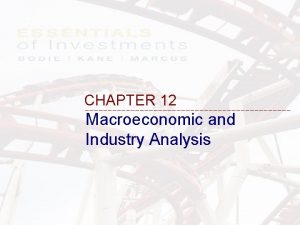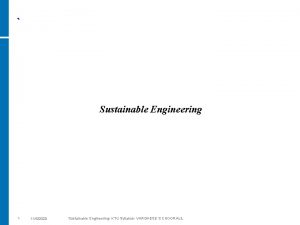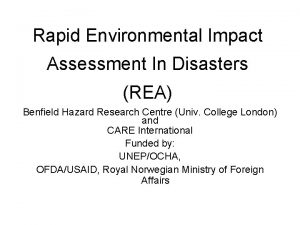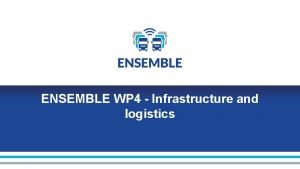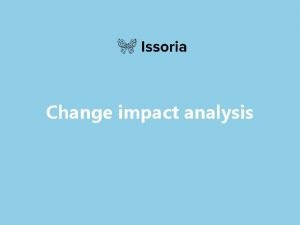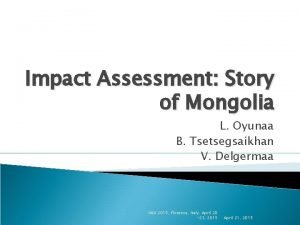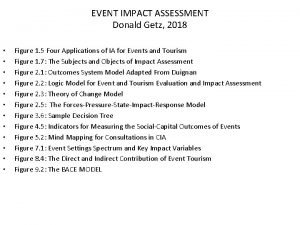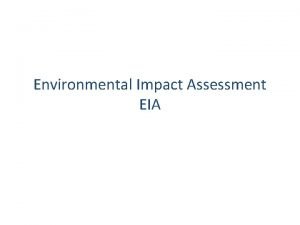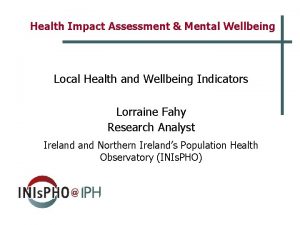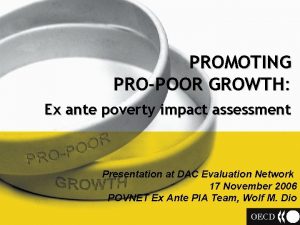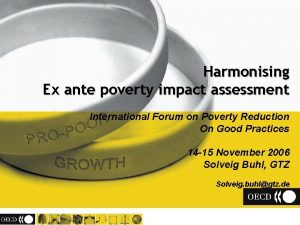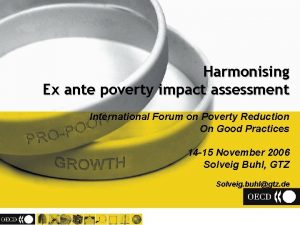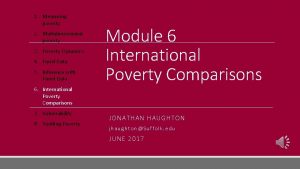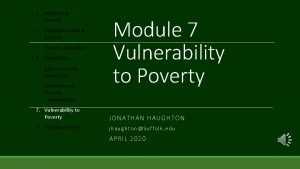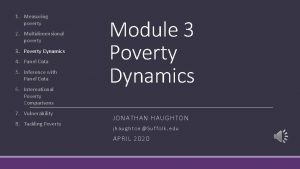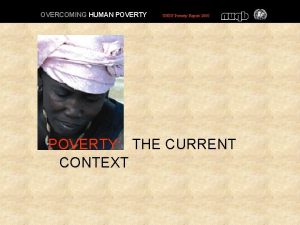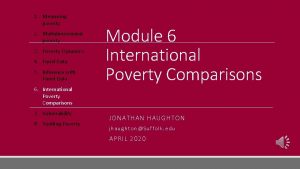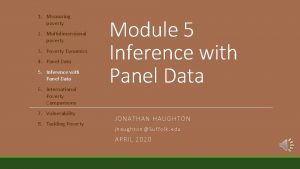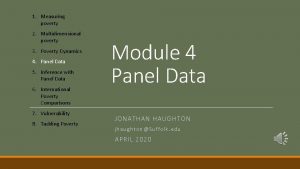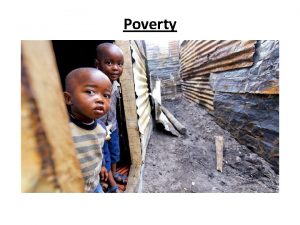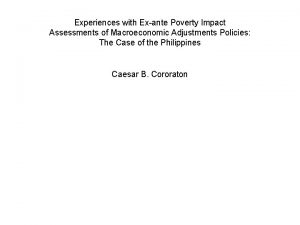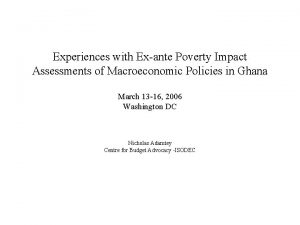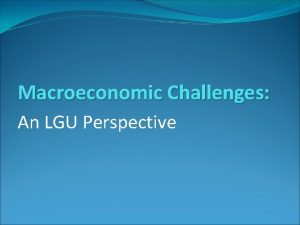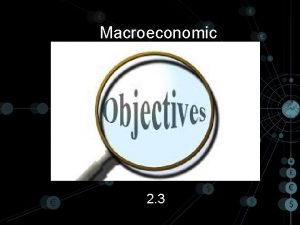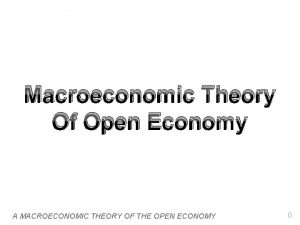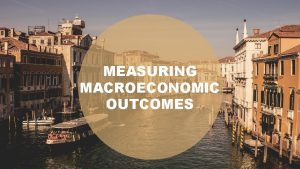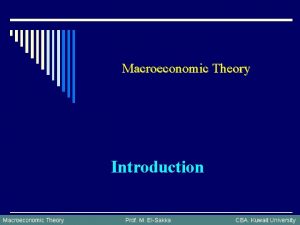Ex Ante Poverty Impact Assessment of Macroeconomic Policies

























- Slides: 25

Ex Ante Poverty Impact Assessment of Macroeconomic Policies A Case Study of Bangladesh Mustafa K. Mujeri

Introduction • Noteworthy performance especially in social development despite initial pessimistic predictions • Well-informed policy making important for fostering pro-poor growth • Despite limited role, EPIAs sharpened poverty focus of policy regime in the past • EPIAs can be significant catalyst in future

Objectives/Methodology • Examine available tools and capacity; identify constraints; suggest measures to ensure more informed and effective decision making through promoting credible EPIAs • Variety of methodologies. e. g. descriptive analysis; interviews; reviews covering adequacy of existing tools, availability of capacity, degree of participation among ‘producers’ and ‘consumers’, and willingness and capability to formulate research-based macro-policies

Structure of Study • Section I: Introduction • Section II: Background-context of evolved policies in terms of (i) development and poverty trends; and (ii) different policy regimes creating ‘turning points’ in growth-history • Section III: Role of EPIAs examined in terms of three key instruments: (i) tools of analysis; (ii) capacity to support policy making; and (iii) openness and elasticity of policy regime to new ideas and policy innovations • Section IV: Constraints and measures including examples of successful contribution • Section V: Conclusions and elements of a successful strategy

Macroeconomic Performance and Poverty • Per capita GDP growth rate increased in 1990 s due to higher economic growth and falling population growth • Some parts of all sectors emerged as rapidly growing activities • Incidence of poverty consistently declined in 1990 s • Inequality increased considerably especially in urban areas

Contd. • Several sources of inequality e. g. non-farm enterprises, non-agricultural jobs, remittances, property income etc. • Structural change in rural non-farm sector: more expansion of wage-labor based larger enterprises in 1990 s than lowearning self-employment activities • Well-off groups were major gainers

Contd. • Implications: Limited opportunity of pursuing growth and equity within sectoral growth pattern • Importance of pursuing ‘asset building’ policies of the poor for accessing growth opportunities. • Two important issues: (i) scope of pursuing policies to address inequality without affecting growth; and (ii) nature of impact of growth maximizing policies on poverty in the face of potentially widening inequality with growth.

Phases in Policy Regime • Four phases using policy-based periodization • Phase I (1971 -1982): Reconstruction and recovery amidst political turbulence • Phase II (1983 -1989): Growth with growing macroeconomic instability • Phase III (1990 -1993): Crisis-driven economic reforms and formation of favorable initial condition state • Phase IV (1994 -2005): Higher economic growth and faster social development

Contd. • Three important factors: first, shift in fundamental development philosophy; second, wave of globalization; third, emergence of economic crisis • Continuing themes of policy consistency: e. g. emphasis on social development, grassroots mobilization, women’s empowerment

Ex Ante Impact Assessments • Tools and contents of analysis: wide varieties; government-sponsored and donor-supported initiatives; independent civil society efforts especially in 1990 s; partnership approach (e. g. MIMAP) • In-country capacity: human skills scattered in government and non-government institutions (formal/informal collaboration); number of mandated agencies increased; lack of adequate earmarked resources; lack of sustainability; varying strength of researcher-policy maker relationships.

Contd. • Role of participation: largely context-specific. Presence of strong interest groups on issues of ‘hard decisions’; variation in capacities, differences of opinion, limited ability to master adequate support to exert a threshold level of pressure on policy makers to change • Combined role of researchers and ‘coalitions for change’: solidarity and unity between civil society and researchers/advocacy groups on specific issues

Contd. • Three major routes by which EPIAs contributed to improved policy making: (i) expanded policy capacity by improving knowledge base; (ii) broadened policy horizons through networking, dialogues, cross-fertilization; and (iii) changing policy regime by modifying and/or re-designing existing policies

Constraints and Possibilities • Institutional Dimension: fragmented jurisdiction of government institutions; low level of coordination within policy making institutions; lack of transparency and accountability resulting in generally inefficient, time-consuming and largely ineffective decisions; lack of motivation and incentives to promote credible policy making; inadequate reflection of country’s unique characteristics making policies less responsive to ground realities

Contd. • Role of intermediary institutions: professional bodies and ‘lobbying groups’ • Multi-level dimensions and complexity of institutional culture: need to promote an issue to attract attention and ensure participation of key policy makers.

Contd. • Relevance of EPIAs: Two important factors: (i) how EPIAs were conducted; and (ii) for what purpose. • Several determinants e. g. quality of research; effective interpretation; identification of feasible options and likely outcomes; participation of and consultation with relevant parties; and nature of research-policy nexus.

Examples • Pro-Poor Growth: Adequacy of growth maximizing policies; e. g. growth path under ‘growth maximization’ strategy vs. ‘pro-poor growth’ strategy; poverty reduction outcomes under alternative strategies; likely trade-offs in choice of strategies etc. and plausible mix of ruralurban policies.

Contd. • Trade Liberalization: MIMAP analysis with CGE framework and use of double-calibration GE methodology. • Major policy conclusions: gains and losses relatively small; differ across household groups determined by transmission channels; generally benefits accrue more to well-off households; abilities to adjust differ with access to and participation in socio-economic transactions.

Contd. • Increasing ‘wage-divide’ between skilled and unskilled workers and poverty implications; skillbiased technical change significant determinant of wage inequality. • Reducing wage divide can produce large positive income effect on the poor; needs education and skill up-gradation of abundant unskilled labor; • Overall, trade reforms neither readily nor necessarily benefited the poor; need to effectively manage liberalization process.

External Influence on Policy • Often played key role in breaking statusquo and acted as dominant force: SAF and ESAF during mid-1980 s; different forms at different times • Turning to new sources for policy advice by different regimes; brings new players and new ideas into prominence both inside and outside government

Research-Policy Links • Broader issue: how and to what extent research can and does actually influence policy; difficult to measure. • Depends on a host of factors, e. g. quality of research, ability to address policy problem in a credible and timely manner, nature of policy making process, relative ‘weakness’ of policy makers vis-à-vis research community, political and social sensitiveness of the policy issue, strength of linkages between policy makers and researchers etc. Most of these issues remain inadequately explored in Bangladesh.

Contd. • One bottleneck: distance between researchers and policy makers as separate groups; over time becoming somewhat permeable through more frequent movement of researchers into and out of government than in the past • No predictable pattern in policy making; unexpected events (e. g. crisis) often dominated course of policy history in Bangladesh • Opening of ‘policy windows’ has sometimes ensured serious consideration of alternatives to existing policies and/or adoption of new policies

Conclusions • Impact of EPIAs: wider perspective needed in Bangladesh; should not focus on measuring policy change alone; within country’s complex and nascent policy making environment, measuring policy influence should cover intermediate influence as well; often important for building policy capacity and furthering dialogues to enhance chances of adopting research-based policies

Contd. • Research-policy nexus: vaguely understood relationship and inadequate awareness on direct value of EPIAs to policy makers • Positive development: boundaries becoming more permeable • Role of intermediary institutions: ‘transmitting vehicles’ of EPIA policy messages; formal/informal networks

Contd. • Effective ways to deal with fragmented jurisdiction of government institutions in policy making • Forming ‘like-minded’ advocacy coalitions with government/non-government actors • Important issue: take advantage of policy windows, learn to create new windows, play role of ‘policy entrepreneurs’

Contd. • Important to predict nature of policy change: big demand receptivity comes in discrete jumps, e. g. aftermath of political regime change or during ‘defining moments’ • External force: Bangladesh’s aid-dependence declined but no commensurate decline in ‘policy advice’ • Need to make EPIAs powerful tool of effective policy change using new evidence, new arguments and new strategies
 Relative and absolute poverty difference
Relative and absolute poverty difference Unemployment
Unemployment Macroeconomic policy debates
Macroeconomic policy debates Short run macroeconomic equilibrium
Short run macroeconomic equilibrium Macroeconomics deals with
Macroeconomics deals with History of macroeconomic thought
History of macroeconomic thought A macroeconomic theory of the open economy
A macroeconomic theory of the open economy Perlukah pemerintah menyeimbangkan anggaran belanjanya
Perlukah pemerintah menyeimbangkan anggaran belanjanya Six debates over macroeconomic policy
Six debates over macroeconomic policy 5 debates over macroeconomic policy
5 debates over macroeconomic policy Five debates over macroeconomic policy
Five debates over macroeconomic policy Basic macroeconomic relationships
Basic macroeconomic relationships Macroeconomic definitions
Macroeconomic definitions Macroeconomic and industry analysis
Macroeconomic and industry analysis Mcn 201 sustainable engineering syllabus
Mcn 201 sustainable engineering syllabus Hp business continuity
Hp business continuity Cipd experience assessment impact report examples
Cipd experience assessment impact report examples Rapid environmental impact assessment in disaster
Rapid environmental impact assessment in disaster Viscoroute
Viscoroute Change impact assessment template
Change impact assessment template What is environmental impact
What is environmental impact Event impact assessment
Event impact assessment Environmental auditing
Environmental auditing Lmia online pilot
Lmia online pilot Mental wellbeing impact assessment
Mental wellbeing impact assessment Mental wellbeing impact assessment
Mental wellbeing impact assessment
